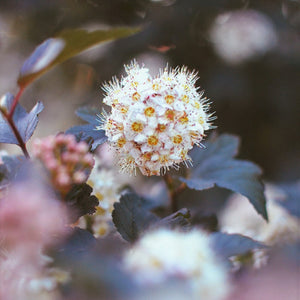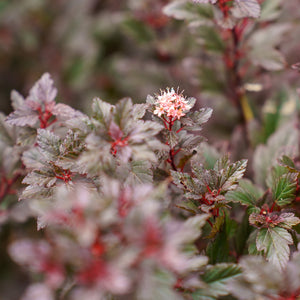The Ninebark Guide
Ninebark (Physocarpus opulifolius) is a tough and ornamental deciduous shrub prized for its dramatic foliage, arching branches, peeling bark, and seasonal blooms. Native to North America, it thrives in a wide range of conditions and offers year-round interest through colorful leaves, spring flowers, and attractive winter bark. Its adaptability, low-maintenance needs, and visual impact make ninebark a staple in contemporary and naturalistic landscapes alike.
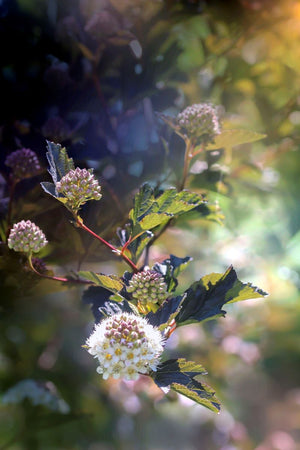
About
Physocarpus opulifolius gets its common name from the way its bark peels away in layers—typically in winter—revealing cinnamon-brown inner bark that provides beautiful texture and contrast. The shrub has an upright, arching form and grows rapidly under the right conditions.
Spring brings clusters of small white or pale pink flowers that appear in domed inflorescences, followed by red seed capsules. Foliage varies widely by cultivar and can range from deep burgundy and copper to lime green and chartreuse.
Notable cultivars include:
- ‘Diabolo’ – A classic dark-leaved variety with deep purple foliage and pinkish flowers.
- ‘Coppertina’ – Copper-colored new growth maturing to rich burgundy.
- ‘Little Devil’ – A compact form with deep reddish-purple leaves and a tidy habit.
- ‘Summer Wine’ – Rounded growth with wine-red foliage and good disease resistance.
- ‘Amber Jubilee’ (‘Jefam’) – Bright new growth in orange, gold, and red tones.
Ninebark is often used in privacy plantings, shrub borders, and erosion control projects. Its resilience, pest resistance, and striking color variations have made it a favorite for modern landscapes.
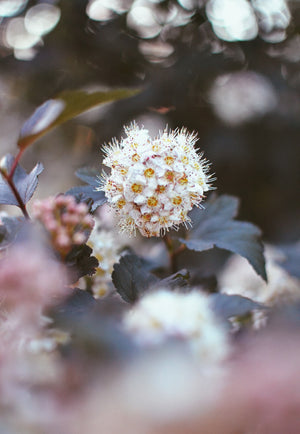
PLANTING
Ninebark is easy to establish and adapts well to a variety of soil and light conditions.
USDA Hardiness Zones: Most varieties are hardy in Zones 3–7, with some extending into Zone 8 depending on microclimate.
Soil: Prefers well-drained soil but tolerates clay, rocky soil, and occasional drought. It does best in average to slightly acidic soils.
Sunlight: Full sun to part shade. Full sun encourages the best foliage color, especially for dark-leaved or variegated cultivars. In hot climates, some afternoon shade is beneficial.
Watering: Moderate water needs. Water regularly during the first growing season. Once established, ninebark is drought-tolerant.
Spacing: Space plants 3 to 6 feet apart depending on the mature width of the selected cultivar.
Planting Time: Plant in spring or fall for best root development. Avoid planting in summer heat unless supplemental water is provided.
CARE
Watering: Keep the soil evenly moist during establishment. Mature plants need water only during extended dry periods.
Fertilizing: Feed with a balanced fertilizer in early spring to promote healthy foliage and blooms. Avoid excessive nitrogen, which can lead to weak stems.
Pruning: Prune immediately after flowering in late spring or early summer to shape the plant or rejuvenate older stems. Cut back one-third of the oldest stems to the ground every few years to maintain vigor. Avoid late-season pruning, which can encourage tender growth susceptible to winter damage.
Pests and Diseases: Generally pest-free and disease-resistant. Powdery mildew can occur in humid climates, especially on older cultivars. Good air circulation and resistant varieties help minimize issues.
Mulching: Apply mulch to conserve moisture, regulate soil temperature, and suppress weeds. Keep mulch a few inches away from stems to prevent rot.
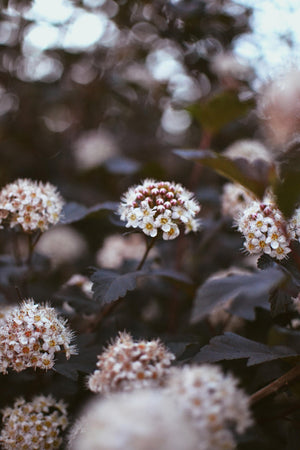
HOW TO USE
Focal Point: Larger varieties like ‘Diabolo’ or ‘Amber Jubilee’ serve as striking focal points in borders or mixed shrub plantings. Their rich leaf color and winter bark add dimension across seasons.
Hedges and Screens: Use mid- to tall-growing cultivars for informal hedges or privacy screens. They offer dense foliage in summer and visual interest through winter.
Foundation Plantings: Compact selections like ‘Little Devil’ are excellent near homes or patios, offering color without overwhelming tight spaces.
Mixed Borders: Pair ninebark with ornamental grasses, hydrangeas, spirea, or perennials like coneflowers and rudbeckia. Their contrasting textures and bloom times enhance seasonal interest.
Pollinator Gardens: The small, nectar-rich flowers attract bees and butterflies. Plant near other pollinator-friendly species like salvia, coreopsis, or bee balm.
Slope and Erosion Control: Ninebark’s fibrous root system makes it useful for stabilizing banks and controlling erosion. Its hardiness and fast growth fill in bare spots quickly.
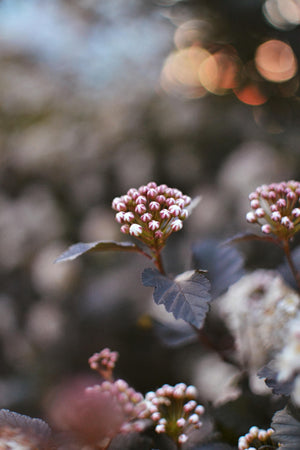
Common Questions
When to prune ninebark? Prune right after the plant finishes blooming in late spring to preserve the current year’s flower display. Rejuvenation pruning can be done every few years.
How to prune ninebark? Remove dead or damaged wood and thin out crowded stems. For rejuvenation, cut the oldest stems to the ground to encourage new growth.
Is ninebark poisonous to dogs or cats? Ninebark is not considered toxic to pets, though ingestion of any plant material may still cause mild gastrointestinal upset.
Do deer or rabbits eat ninebark? Ninebark is generally deer- and rabbit-resistant, making it a good choice in wildlife-heavy areas.
Is ninebark invasive? While not listed as invasive in most regions, ninebark can spread via suckers or self-seeding in favorable conditions. Monitor and manage growth where needed.
How big does ninebark get? Size varies widely by cultivar, ranging from 3 to 10 feet tall and wide. Compact types stay under 4 feet, while large forms can exceed 8 feet.
How fast does ninebark grow? Ninebark is a fast-growing shrub, often adding 1 to 2 feet of growth per year under ideal conditions.
How much sun does ninebark need? Full sun is ideal for best foliage color and flower production. It tolerates partial shade but may appear leggier and less colorful.
When does ninebark bloom? Ninebark typically blooms in late spring to early summer, with flower clusters lasting for several weeks.
Conclusion
Ninebark combines vibrant foliage, exfoliating bark, and tough adaptability in one show-stopping shrub. Whether used as a focal point, hedge, or erosion control plant, it delivers color and texture across all seasons. With a wide range of sizes and shades, from copper to burgundy to lime green, ninebark offers a dynamic option for gardens seeking low-maintenance structure and high-impact beauty.
The Ninebark Collection
Sold Out
Sold Out

